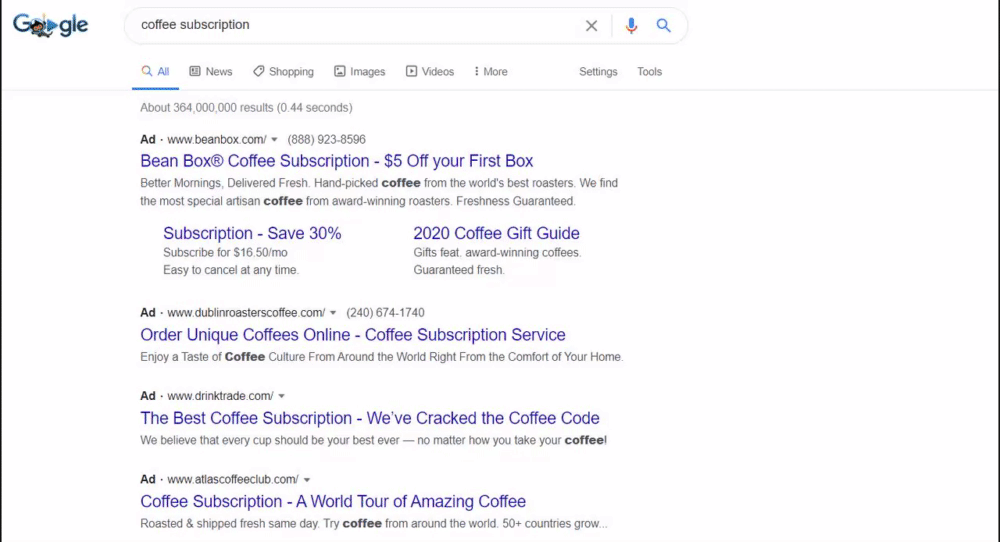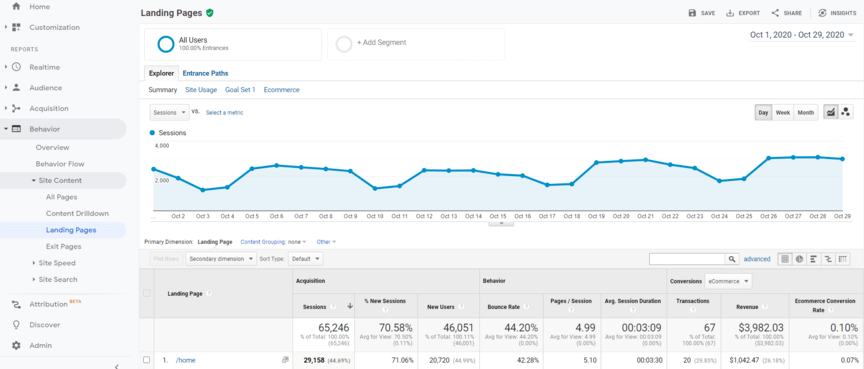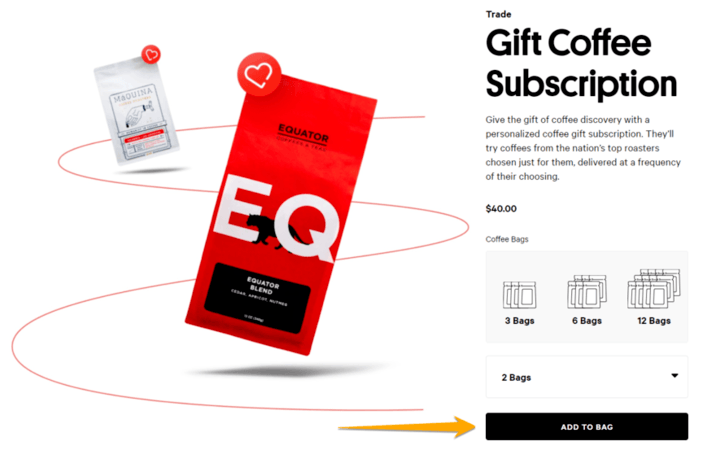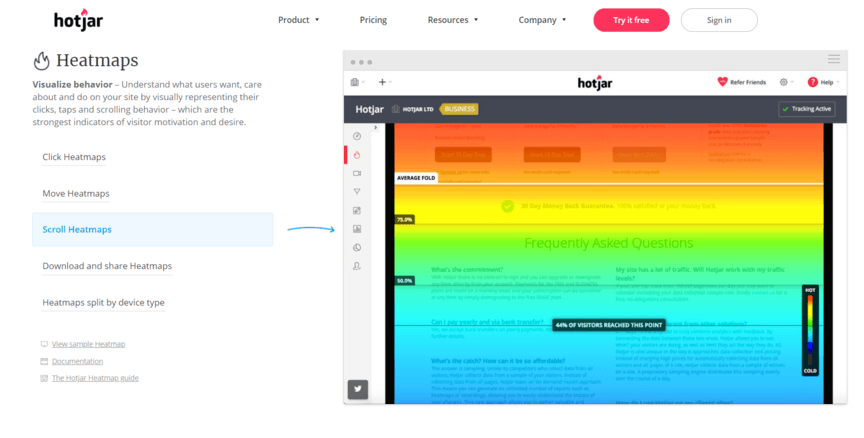-
 13 min. read
13 min. read
-
 Sarah Berry
Sarah Berry Lead Web Marketing Consultant
Lead Web Marketing Consultant
- Sarah Berry is a Lead Web Marketing Consultant at WebFX. With more than 10,000 hours of experience, she offers practical insights and strategies you can use to grow your digital revenue. When she isn’t polishing her Time Magazine Person of the Year Award, she’s spending time with her flock of ducks.
Every business can improve its conversion rates with effective strategies. That’s why brands like Spotify, Adidas, and Eurobank all make time for conversion rate optimization (CRO) — and have seen impressive results from their efforts. Spotify increased subscriptions by 24% with its conversion rate optimization strategy, demonstrating the impact of targeted techniques like A/B testing and user experience enhancements.
How can your business see similar (or even better) results?
With these CRO strategies:
- Create landing pages and A/B test them
- Test above the fold
- Run CRO tests on high-traffic pages
- Use PIE to prioritize CRO tests
- Experiment with text-based calls-to-action (CTAs)
- Gather behavior data with CRO tools
- Add trust signals, like ratings and certifications
🎥Video: Common CRO mistakes to avoid
Keep reading to learn how to improve your conversion optimization strategy with the above examples. For even more tips on how to earn more leads and revenue from your site, join the newsletter that more than 200,000 marketers trust — Revenue Weekly!
1. A/B test landing pages using unique CRO strategies on each page
Landing pages describe where a user arrives on your site. If you run an ad campaign, for instance, you’ll set a landing page. When users click on your ad, they “land” on that page.
What’s great about landing pages (in this example) is that you don’t have to optimize them for search engine optimization (SEO) in addition to CRO.  Instead, you can focus all your attention on your CRO strategy to maximize that page’s conversions. That’s why businesses with ad campaigns should run CRO tests on their landing pages.
Instead, you can focus all your attention on your CRO strategy to maximize that page’s conversions. That’s why businesses with ad campaigns should run CRO tests on their landing pages.
With tweaks to your CTAs, design, content, or colors, you could drive even more conversions from ads and achieve an even better return on ad spend (ROAS). Even if you’re not advertising online, it’s worthwhile to run A/B tests on your landing pages. These pages serve as a critical touchpoint, which is why you want to experiment with ways to:
- Keep users on your site longer
- Move users to action, like by downloading a guide or purchasing a product
- Provide users with a more relevant and memorable experience
The best part is that if you can increase conversions on your non-advertising landing pages, it’ll often send a positive signal to search engines, which can increase your rankings. That’s because, since users took an action on your site, they likely stayed on your website vs. bouncing back to the search results.
2. Incorporate CRO strategies above the fold
Almost every conversion optimization strategy considers the above the fold area, which is what users see when they first arrive at your site. It’s the content before people have to scroll to see more. If you don’t provide compelling content and design above the fold, you’ll lose valuable traffic and revenue.
 You can test a variety of elements above the fold, including:
You can test a variety of elements above the fold, including:
- Headings
- CTAs
- Design
- Trust signals
- Navigation
- Content
- Images
When choosing what to test, remember to think about your audience and what they want. In most cases, your above the fold area won’t magically convince users to purchase your product or download your guide. However, that above-the-fold real estate can persuade people to read more about your product’s uses or investigate your guide’s content.
Essentially, you want to optimize your above the fold to hook audiences and get them to stay. Take the example of Trade Coffee, a coffee subscription service.  The above-the-fold area on the homepage doesn’t ask users to open their wallets and book their first delivery.
The above-the-fold area on the homepage doesn’t ask users to open their wallets and book their first delivery.
Instead, the above-the-fold CTA asks for a smaller commitment: Take a quiz and get personalized coffee recommendations. This CTA hooks users and gets them to stay on the site, plus moves them closer to becoming subscribers. Your company can hook people too, whether you sell to consumers or business buyers.
Just take the time to brainstorm ways for your conversion optimization strategy to engage your target audience, whether through a quiz, tool, study, or something else.
3. Run CRO tests on high-traffic pages
Traffic powers CRO tests because, without traffic, you get zero feedback. Of course, it’s not enough to just have traffic — you also need a lot of traffic if you want to run CRO tests frequently and accurately. A pool company that runs a CRO test from the spring to the summer, for instance, will likely get inaccurate results because of the seasonal changes in user intent.
That’s why businesses should focus their conversion rate optimization strategy on high-traffic pages.  If you use a tool like Google Analytics, you can find your traffic titans by following these steps:
If you use a tool like Google Analytics, you can find your traffic titans by following these steps:
- Log in to your Google Analytics account
- Choose “Behavior”
- Click “Site Content”
- Select “Landing Pages”
For the best results, set a date range of around three months. This view will provide you with a broader view of a page’s performance, which can help you choose pages to test that consistently bring in traffic. If you operate seasonally, you may want to look at traffic data from your peak months vs. off-season.
4. Use PIE to prioritize CRO tests
Depending on your business and website performance, you may have dozens of options when it comes to pages to test. Even if you only have a few high-traffic pages to test, you may have plenty of ideas for what to test. So, how do you decide where to focus your time?
With PIE:
- Potential: How much potential is there for improvement on a page?
- Importance: How valuable is this page and its traffic?
- Ease: How easily can you create and launch this test?
With the PIE framework, you can prioritize your tests. Generally, PIE will guide you towards high-value pages, like:
- Service pages
- Product pages
- Checkout pages
- Contact page
In most cases, it’s smart to focus your time on bottom-of-the-funnel pages, like those mentioned above, because they can have the most impact on your business and its bottom line. Again, though, you’ll want to consider traffic quantity when choosing your test pages in order to build an optimal conversion rate optimization strategy.
5. Experiment with non-button CTAs
When it comes to CTAs, they often reside on buttons. That’s because buttons typically stand out on a page and catch a user’s attention. People even look for buttons, like when looking to add a product to their cart.
 A lot of CRO strategies also revolve around buttons and changing their:
A lot of CRO strategies also revolve around buttons and changing their:
- Color
- Shape
- Text
- Size
What if your business, though, could earn more conversions by adding text-based CTAs? You won’t find out until you try, but this conversion optimization strategy offers potential when it comes to top-of-the-funnel and middle-of-the-funnel content. If you want to persuade users to download a related ebook, for instance, you may include relevant CTAs in a related blog post.
For example, take the following scenario: “At-home coffee makers can choose from dozens of coffee grinders — check out our round-up of the best coffee grinders to learn more — but it’s not just your coffee grinder that makes your brew a win or a loss…” In this example, there’s a CTA to view a related article aimed towards middle-of-the-funnel users. For the curious reader, this CTA can seem less transactional and more helpful because of its feature within the text vs. as a button. The best part about this test for your strategy is that it’s easy to implement! You don’t have to ask your developer to add a button or request a designer to build a new wireframe.
Instead, you can add the text yourself.
6. Use tools to gather data and apply findings
If you’re looking at your CRO data and thinking to yourself, “I wonder why…,” you’re on the right track. The best conversion rate optimization strategies ask why because the answers often reveal new test ideas or user insights that can help accomplish your goals, from improving email subscriptions to product purchases. One way to answer your “Why?” is with a more data-driven, tool-based approach.
 CRO software, like Hotjar, is a tool that provides valuable information about your visitors, like:
CRO software, like Hotjar, is a tool that provides valuable information about your visitors, like:
- How far they scrolled on a page
- Where they clicked on a page
- How far they progressed on a form
- And more
Based on this data, you can (somewhat) understand the user experience. You can also spot issues. For instance, maybe you have a link on your homepage that doesn’t work or a form field with strict requirements that remain hidden until a user hits “Submit.” Often, you’ll get some surprises when looking at data from your CRO tool.
You can use that data to your advantage, though, and guide your conversion optimization strategy with data vs. hunches about why people didn’t act as predicted.
7. Add trust signals, like ratings and certifications
People rarely purchase from companies they do not trust. That’s why trust signals are one of the most critical factors in creating a great conversion rate optimization strategy.
When you incorporate trust signals, like ratings, testimonials, and certifications, into your site’s design and copy, you can often persuade users to consider (and even choose) your business. So, many conversion rate optimization strategies focus on experimenting with trust signals and their:
- Location
- Size
- Content
- Type
For example, your business could A/B test which review or testimonial features on your homepage. Or, you could experiment with a social media feed on a product page that highlights the user-generated content of that product. On its homepage, for instance, Trade Coffee highlights media outlets that have talked about the brand.
 The company’s website also uses HTTPS, which offers extra security for users.
The company’s website also uses HTTPS, which offers extra security for users.
That’s critical for ecommerce sites, like Trade Coffee and every other website since HTTPS operates as a ranking factor for SEO. ![]() Get ideas for how you can use trust signals by browsing sites in and outside your industry! With these seven conversion rate optimization strategies, your business can start using CRO to:
Get ideas for how you can use trust signals by browsing sites in and outside your industry! With these seven conversion rate optimization strategies, your business can start using CRO to:
- Grow your website traffic
- Increase your online advertising ROI
- Improve your website conversion rates
- Understand your target market
- And more
So, begin developing your conversion optimization campaign and helping your company grow!
FAQs about CRO and CRO strategies
If you still have some questions about CRO and CRO strategies, check this FAQ:
What is conversion rate optimization?
Conversion rate optimization, also called conversion optimization, is the process of testing different variations of a page to increase conversions. Companies will often use CRO tools, like Google Optimize, to run conversion optimization experiments.
🎥Video: Conversion optimization basics
Why should my business prioritize a conversion rate optimization strategy?
Your business should make time for CRO and a CRO strategy because conversion optimization helps you:
- Make data-backed decisions about your website and its content
- Understand your target audience, like what they find compelling and persuasive
- Increase your conversion rates, whether for top- or bottom-of-the-funnel actions
- Improve advertising returns by optimizing landing pages for conversions
Companies provide themselves with a competitive advantage when they stay updated in the latest CRO trends and invest in CRO strategies. You get actionable data and feedback from your audience. Whether a test fails or succeeds, you learn something that you can implement on your site or in your next test.
What are the best tools for building a conversion optimization strategy?
The best tool for CRO is Google Optimize because it:
- Costs $0.00 — though Google Optimize 360 is paid
- Syncs with Google Analytics
- Offers a visual test builder, which means zero coding knowledge required
- Supports multiple test types, including A/B tests, redirect tests, and more
You can support your conversion rate optimization strategy with additional tools, too. Hotjar, for instance, is a free tool that provides heatmap, click, and visitor recording data that you can use to inform the CRO tests you create in Google Optimize.
What should my CRO strategy measure?
While CRO strategies typically measure conversion rate, yours can measure other metrics too, like:
- Bounce rate
- Pageviews
- Session duration
- Google Analytics events
For the best results, you’ll want to focus on the metrics that matter to your business. If you’re looking to increase pageviews from specific landing page traffic so you can nurture more top-of-the-funnel traffic, then do it. With the PIE framework, though, you’ll likely spend more of your conversion optimization strategy on bottom-of-the-funnel pages — at least at the start.
What should I do if I don’t have time for CRO?
When it comes to digital marketing, CRO is a valuable supporting strategy.
As your business begins to earn more traffic from your SEO efforts, for instance, it becomes more important to start investing time into CRO. That’s because, with an effective strategy, you can get the maximum value from your existing traffic. If you don’t have time for CRO, though, it’s worth considering hiring a top CRO agency.
A conversion optimization agency, like WebFX, can take on the responsibility of managing, implementing, and growing your CRO strategy with conversion rate marketing. So, you can get all the benefits of CRO (and the glory) without having to find the time to do it.
Launch your conversion rate optimization strategy and start earning more revenue from your website traffic
Your conversion optimization strategy is the backbone of your CRO success. With a well-researched strategy, you can invest your time into tactics, like experimenting with trust signals, that will offer your business the best chance at success.
Even if you don’t have the time or resources to do CRO in-house, you can still benefit from it by partnering with a CRO agency. With conversion rate optimization services from WebFX, your business gets everything it needs to improve its conversion rates. From a CRO expert to a web developer, our team takes care of developing, launching, and measuring your results so you can focus on all those new leads and online orders.
Learn more about our CRO services by contacting us online or calling us at 888-601-5359 today!
-
 Sarah Berry is a Lead Web Marketing Consultant at WebFX. With more than 10,000 hours of experience, she offers practical insights and strategies you can use to grow your digital revenue. When she isn’t polishing her Time Magazine Person of the Year Award, she’s spending time with her flock of ducks.
Sarah Berry is a Lead Web Marketing Consultant at WebFX. With more than 10,000 hours of experience, she offers practical insights and strategies you can use to grow your digital revenue. When she isn’t polishing her Time Magazine Person of the Year Award, she’s spending time with her flock of ducks. -

WebFX is a full-service marketing agency with 1,100+ client reviews and a 4.9-star rating on Clutch! Find out how our expert team and revenue-accelerating tech can drive results for you! Learn more
Try our free Marketing Calculator
Craft a tailored online marketing strategy! Utilize our free Internet marketing calculator for a custom plan based on your location, reach, timeframe, and budget.
Plan Your Marketing Budget
Table of Contents
- 1. A/B test landing pages using unique CRO strategies on each page
- 2. Incorporate CRO strategies above the fold
- 3. Run CRO tests on high-traffic pages
- 4. Use PIE to prioritize CRO tests
- 5. Experiment with non-button CTAs
- 6. Use tools to gather data and apply findings
- 7. Add trust signals, like ratings and certifications
- FAQs about CRO and CRO strategies
- Launch your conversion rate optimization strategy and start earning more revenue from your website traffic

Proven Marketing Strategies

Proven Marketing Strategies
Try our free Marketing Calculator
Craft a tailored online marketing strategy! Utilize our free Internet marketing calculator for a custom plan based on your location, reach, timeframe, and budget.
Plan Your Marketing Budget
What to read next





